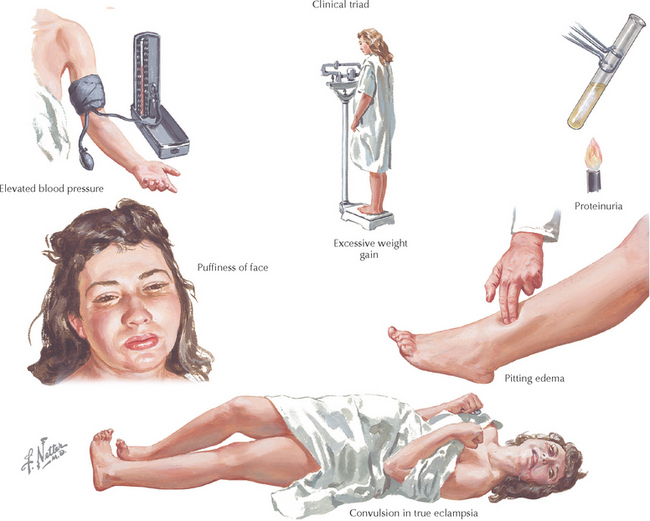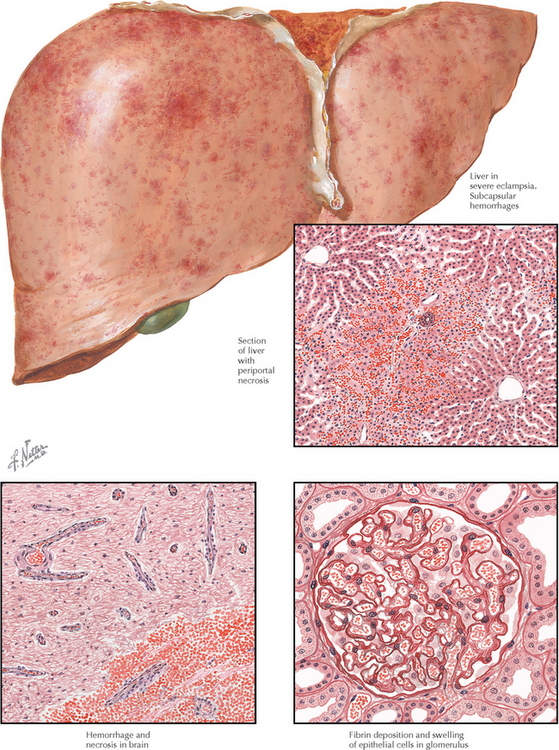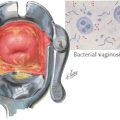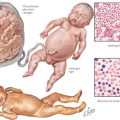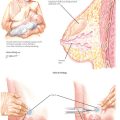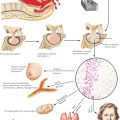Chapter 219 Pre-Eclampsia and Eclampsia (Toxemia of Pregnancy)
INTRODUCTION
ETIOLOGY AND PATHOGENESIS
CLINICAL CHARACTERISTICS
DIAGNOSTIC APPROACH
Workup and Evaluation
MANAGEMENT AND THERAPY
Nonpharmacologic
| Pre-eclampsia (Mild) | Severe Pre-eclampsia (One or More) |
|---|---|
Drug(s) of Choice
FOLLOW-UP
Barrilleaux PS, Martin JNJr, Klauser CK, et al. Postpartum intravenous dexamethasone for severely preeclamptic patients without hemolysis, elevated liver enzymes, low platelets (HELLP) syndrome: a randomized trial. Obstet Gynecol. 2005;105:843.
Livingston JC, Livingston LW, Ramsey R, et al. Magnesium sulfate in women with mild preeclampsia: a randomized controlled trial. Obstet Gynecol. 2003;101:217.
Lucas MJ, Leveno KJ, Cunningham FG. A comparison of magnesium sulfate with phenytoin for the prevention of eclampsia. N Engl J Med. 1995;333:201.
Magpie Trial Follow-Up Study Collaborative Group. The Magpie Trial: A randomised trial comparing magnesium sulphate with placebo for pre-eclampsia. Outcome for children at 18 months. BJOG. 2007;114:289. Epub 2006 Dec 12
Magpie Trial Follow-Up Study Collaborative Group. The Magpie Trial: A randomised trial comparing magnesium sulphate with placebo for pre-eclampsia. Outcome for women at 2 years. BJOG. 2007;114:300. Epub 2006 Dec 12
Askie LM, Duley L, Henderson-Smart DJ, Stewart LA, PARIS Collaborative Group. Antiplatelet agents for prevention of pre-eclampsia: a meta-analysis of individual patient data. Lancet. 2007;369:1791.
Conde-Agudelo A, Villar J, Lindheimer M. World Health Organization systematic review of screening tests for preeclampsia. Obstet Gynecol. 2004;104:1367.
Coomarasamy A, Honest H, Papaioannou S, et al. Aspirin for prevention of preeclampsia in women with historical risk factors: a systematic review. Obstet Gynecol. 2003;101:1319.
Nassar AH, Adra AM, Chakhtoura N, et al. Severe preeclampsia remote from term: labor induction or elective cesarean delivery? Am J Obstet Gynecol. 1998;179:1210.
American College of Obstetricians and Gynecologists. Chronic hypertension in pregnancy. ACOG Practice Bulletin 29. Obstet Gynecol. 2001;98:177.
American College of Obstetricians and Gynecologists. Diagnosis and management of preeclampsia and eclampsia. ACOG Practice Bulletin 33. Obstet Gynecol. 2002;99:159.
Brown MA, Mackenzie C, Dunsmuir W, et al. Can we predict recurrence of pre-eclampsia or gestational hypertension? BJOG. 2007;114:984. Epub 2007 Jun 14
Duley L, Meher S, Abalos E. Management of pre-eclampsia. BMJ. 2006;332:463.
Martin JNJr, Rose CH, Briery CM. Understanding and managing HELLP syndrome: the integral role of aggressive glucocorticoids for mother and child. Am J Obstet Gynecol. 2006;195:914. Epub 2006 May 2
Sibai BM. Treatment of hypertension in pregnant women. N Engl J Med. 1996;335:257.
Sibai BM. Diagnosis and management of gestational hypertension and preeclampsia. Obstet Gynecol. 2003;102:181.
Sibai BM. Magnesium sulfate prophylaxis in preeclampsia: lessons learned from recent trials. Am J Obstet Gynecol. 2004;190:1520.
Sibai BM. Diagnosis, prevention, and management of eclampsia. Obstet Gynecol. 2005;105:402.
Sibai BM. Imitators of severe preeclampsia. Obstet Gynecol. 2007;109:956.
Sibai B, Dekker G, Kupferminc M. Pre-eclampsia. Lancet. 2005;365:785.
Witlin AG, Sibai BM. Magnesium sulfate therapy in preeclampsia and eclampsia. Obstet Gynecol. 1998;92:883.
Zhang J, Villar J, Sun W, et al. Blood pressure dynamics during pregnancy and spontaneous preterm birth. Am J Obstet Gynecol. 2007;197:162.e1.

